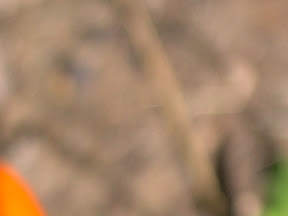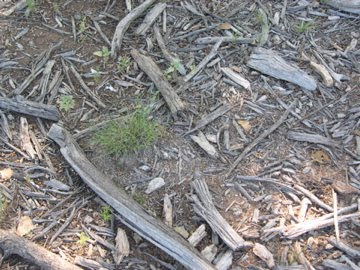Jill Christian
Advisor: Laurel Sparks
Comparison Paper
1 October 2009
Looking More: Thoughts on the Abstraction of Daniel Brice and Udo NögerThe two paintings I have chosen for my comparison are
S.F. 3 by Daniel Brice (Figure 1) and
Links-rechts (Figure 2) by Udo Nöger.
These two artists and the paintings I observed appear to be very far from my own style, concerns, and techniques. However, seeing these works, I was drawn into the paintings by the beauty and subtlety of the ranges of cool and warm whites, the spare compositions, the structure, and energetic quietness that seemed to emanate from their surfaces. And I started to think about how they might connect to the struggles I am having with my own painting this semester, and what I might learn.
Although both artists are minimalist and abstract in their overall visual approach: simplified shapes and forms, limited color palette of variations of white on white; there are vast differences in these works that require close looking. Kirk Varnedoe in
Pictures of Nothing: Abstract Art Since Pollock cautions that abstract art is “also crucially about experience and about particulars. The less there is to look at, the more important it is that we look at it closely and carefully. This is critical to abstract art. Small differences make all the difference” (Varnedoe 8).
Brice’s
S.F. 3 is deceptively simple: a relatively small (28”x24”) overall white painting, divided roughly in half by two black curvilinear lines that are almost flipped mirror images of each other. As I looked more closely, however, I found surprises in the work, specifically in the illusion that the painting is structured around collage elements.
In
S.F. 3, Brice has used a grid structure to divide the canvas into roughly four unequal quadrants, delineated by overlapping rectangles and two curvilinear lines originating at opposite corners of the painting. Though the geometric quadrants appear to be created through a collage process, Brice has in fact carefully built up the surface, using paint and medium, on an underlying structure of stretched burlap, creating raised relief-like edges at the intersections and edges of the geometric forms, imitating the effect of paper collage. The surface has a smooth, encaustic-like texture, which Brice has created through a process of repeatedly applying, sanding down, and painting over. Brice allows color elements to show through from below (the ruby red line running across the bottom of the canvas and the orange line running halfway down the upper right side of the canvas, as well as hints of color barely visible through the waxy surface). This creates veils of whites, some cool, some warm.
Figure 1. Daniel Brice. S.F. 3. 2009. Mixed media on burlap, 28"x24". Courtesy of Chiaroscuro Gallery, Santa Fe.
The linear elements, which at first appear to be paint, are in fact created with charcoal. Both lines begin off the edge of the canvas, suggesting the space beyond it. The edges of the line vary -- at places crisp-edged and hard. In other places, Brice allows the edge to smudge into the white surface where it seems to become encased in the surface. At the intersection of the lines with the edge of the collage overlay, the edge of the white overlay comes transparent. Most interesting, the linear element that begins in the top right corner almost seems to slip in between the white paper edges, travel in back of it, and then re-emerge on the other side.
This is one of the most interesting elements that I noticed in Brice’s work – a sense of shapes being cut out and pieced together. A sense that a surface is being penetrated and woven through. Almost as if you could pick up a corner of one of the white layers, lift it up and peek behind it.
In Udo Nöger’s painting,
Links-rechts, you literally could lift up the surface to peer behind the canvas. Where Brice “tricks” the viewer into seeing collage with his use of surface materials, Nöger hides the “trick” inside his canvas.
Nöger creates his ethereal paintings using three layers of canvas. The back layer of canvas serves as a backing, which Nöger in some paintings will push forward towards the middle layer. The middle layer is a combination of cut outs and painting on the surface, worked to create specific shapes and light effects. The top layer of canvas is an intact piece that has been soaked in mineral oil to make it translucent, and then dried. This process creates a structure that allows ambient light to penetrate through the outside layer into the other layers and back out to the viewer, like a light box.
Figure 2. Udo Noger. Links-rechts. 2007. Mixed media, 60"x80". Courtesy of Gebert Contemporary, Santa Fe.
The effect is a glowing, ethereal surface that appears to have little to no hand of the artist visible. Unlike Brice, where you can see his interaction with materials, there are no brushstrokes visible on the surface of
Links-rechts. This creates a strange disorientation. Before I inquired about Nöger’s process, I spent a great deal of time trying to figure out how the two bands were created across the center of the canvas. Equally mysterious were the small, barely visible, undulating curvilinear shapes playing across the surface. I think of scrim used on a stage to capture light and create atmosphere. I was also reminded of “light and space” artists like Robert Irwin. But rather than creating illusions of surfaces in a gallery space, Nöger is dealing with, as he says, “the guts of a painting, the rough parts of the painting back coming forward, a sort of inside out expression” (e-mail correspondence with Lynda Foshie, Gebert Contemporary, 9/28/09).
I am intrigued by the difference in approaches of these two artists: one building up thick translucent layers of paint and medium on a burlap backing; the other constructing light boxes inside his canvases, deconstructing the interactions of paint and canvas to create a painting where light literally interacts with paint, cutouts, and canvas. On some formal level, both pieces share some of the same qualities. Both deal with a reduced color palette and a simplified, geometric structure.
Interestingly, both Brice and Nöger, speaking of their own development, touch on how their particular forms of minimalism developed out of earlier work influenced by a “busier” and “louder” tradition. Nöger specifically mentions his German Expressionist influences in a 2005 interview with Rocky Mountain News, saying that in 1991 he was doing “the typical thing that German painters did at that time” (Voelz Chandler). Of his own work, Brice says, “I’m a very physical person, so when I first began to paint, I was attracted to the expressionists and the idea of putting myself fully into the work,” Brice remembered. “I thought the work needed to reflect that with gouges and splashes. I realized later that I didn’t need the external marks to show that I worked through this thing” (Cook-Romero 28).
According to the 2005 article in Rocky Mountain News, “Around 2000, Nöger began to move from dark to light, and to experiment with painted, multilayered canvases dipped in mineral oil, which renders the fabric translucent. ‘It was logical,’ Noger said, ‘to try to reduce things you do to a minimum.” Daniel Brice, in his 2007 artist statement, also mentions reducing his concerns: “My escape in this world comes through the act of making somewhat organized sound. The atmospheric considerations and the linear line are the limited palette, which I feel comfortable working through (Artist statement, Chiaroscuro)
I remembered, and unearthed, a paper I wrote in 1991, titled “Emptying the Object: The Minimalism of Barnett Newman and Kazimir Malevich”, in which I compared Malevich’s
Suprematist Element, White on White of 1918 (MoMA, NY) and Barnett Newman’s
The Voice of 1950 (MoMA, NY). It is interesting to me that 18 years later, I am drawn to works embodying similar minimalist styles, rather than something more akin to the abstract expressionist style I practice. I was attracted specifically because of the phenomenon Varnedoe speaks of – that “the less there is to look at, the more you need to look”. I looked at two paintings, which initially seemed “simple” in composition and execution. Yet, the more I looked, the more nuanced, complicated, and challenging the work became.
Vardenoe says, “the history of abstraction is not, as popularly conceived, a history of libertinism, a history of playing tennis without a net, of allowing oneself every possible freedom. In fact, quite the opposite! Abstraction is to be seen more as a history of denials, of self-imposed rigors and purposely narrowed concentration” (244).
And, reduction of vocabulary, as seen in the work of both Brice and Nöger, has enriched rather than impoverished their images and their psychological effect on me as a viewer. Aside from an aesthetic attraction, I was drawn to these paintings in a time that I have been turning my eye and mind to quieter expressions, as I struggle with the imposing limits on my own work. Whether a paring down becomes a logical step, or a building block for a more personal and complex gestural expression, these paintings demonstrate the richness of “narrowed concentration.”
Works citedBrice, Daniel. Artist statement. 2007. Chiaroscuro Gallery, Santa Fe, New Mexico.
Cook-Romero, Elizabeth. “Pentamerous Perspective.” Pasatiempo/The New Mexican, June 30-July 6, 2006, p 26-28.
The Grove Art Series. From Expressionism to Post-Modernism: Styles and Movements in 20th Century Western Art. Ed. Jane Turner. London: Macmillan Reference Limited, 2000. Print.
Varnedoe, Kirk.
Pictures of Nothing: Abstract Art Since Pollock. Princeton: Princeton University Press, 2006. Print.
Voelz Chandler, Mary. “Two Galleries Create Big Chill.” Rock Mountain News. May 20, 2005.





































